.
17.07.2016
ISRO soon to test-fly scramjet engine model
-
The Indian Space research Organisation (ISRO) is slated to test fly this month a small model of what is called a ‘scramjet’ engine that could one day help to put satellites and other systems to space.
Scientists are quietly keeping their fingers crossed about it. This half-metre, 45-kg model could later grow to power a future dream Indian rocket of two stages (compared to three and four stages at present); a rocket that launches satellites and systems super efficiently at much lower costs than now.
Reliable
The scramjet bid is a move towards faster, cheaper, better rockets; if it works, an eventual launch vehicle using a scramjet engine can be very reliable compared to conventional rocket systems that use liquid or cryogenic systems, said a propulsion scientist who did not want to be named.
In March 2010, the ISRO tested a passive scramjet engine module on a customised sounding (experimental) rocket, named Advanced Technology Vehicle (ATV-D01).
The specialty of the ‘scramjet’ engine is that it ‘inhales’ air from the atmosphere and uses its oxygen to burn. In turn it pushes the vehicle and helps to release the satellite in it to space. Regular launchers now carry liquid oxygen or an oxidiser to fire the engine.
In the upcoming experiment — or demonstration — of the air breathing technology, a small model of a scramjet engine is flown on the experimental ATV to a certain distance in space and ignited. The ISRO expects to sustain the engine for five seconds this time.
K.Sivan, Director of Vikram Sarabhai Space Centre (VSSC) which is the lead centre for launcher activities, had earlier told The Hindu that sustaining the engine burn for even this tiny duration is extremely challenging.
Quelle: The Hindu
---
Jan 10, 2006
ISRO Achieves Breakthrough in Supersonic Combustion Technology
As part of the Advanced technology initiative in the area of Air- Breathing propulsion, the Vikram Sarabhai Space Centre of ISRO at Thiruvananthapuram, has successfully carried out the design, development, characterisation and realisation of the Supersonic Combustion Ramjet (SCRAMJET). Through a series of ground tests, a stable supersonic combustion has been demonstrated for nearly 7 seconds with an inlet Mach number of 6 (i.e., six times the speed of sound).
As such technologies are in a very nascent stage of development the world over, ISRO considers this achievement as a major technology breakthrough in Air- Breathing propulsion. Other than USA, which has recently carried out in-flight demonstration of supersonic combustion for a short duration, work related to supersonic combustor designs in other countries like Japan, China, Russia, Australia , Europe and others are either in their initial or ground testing phase.
Currently, the space transportation systems are expendable in nature and use the conventional chemical rocket systems for their propulsion. The cost per kg of payload of such expendable systems is quite high, and is in the range of $12,000 to $15,000 per kg. If we have to make the access to space more affordable, this cost needs to be brought down by an order of magnitude to something like $500 - $1000 per kg. This will require a two pronged approach (a) the systems are made recoverable and reusable (b) adopt more efficient propulsion systems like Air- Breathing rockets.
Air- Breathing rocket systems are the ones which use the atmospheric oxygen from their surroundings and burn it with the stored on- board fuel for producing the forward thrust in contrast to the conventional chemical rocket systems which carry both the oxygen and the fuel on-board. As a result, the Air-Breathing systems become much lighter and more efficient leading to reduced overall costs. As the Air- Breathing systems have the capability to operate only during the atmospheric phase of flight, they always have to be adopted along with the conventional chemical rockets, for meeting the final orbital velocity requirements.
A good example of Air-Breathing engines is the Turbojet engines used in aircrafts; however, they have limitations in operating only up to a maximum of Mach number 3. To travel beyond these Mach number regimes, SCRAMJET propulsion is the only viable option. The development of SCRAMJET system is quite complex and it involves a number of technological challenges, especially the ones related to the mixing of very high speed air (velocity around 1.5 km/s) with fuel, achieving stable ignition and flame holding in addition to ensuring efficient combustion, within the practical length of the combustor.
In the coming years, ISRO is planning to flight test an integrated SCRAMJET propulsion system comprising of air-intake, combustor and nozzle, by using a cost effective two stage RH-560 sounding rocket. Development of such a high technology system will come in a big way towards meeting the futuristic space transportation needs of our country.
Quelle:ISRO
.
Dec 27, 2006
Indian Space Programme - Major Events During 2006
The Indian space programme continued to make forays in the development of new technologies during the year 2006 with the successful ground testing of indigenous cryogenic stage for GSLV, good progress made in the GSLV-Mk III project and demonstration of Supersonic Combustion Ramjet (SCRAMJET). The Commercial activities picked up momentum with the winning of two contracts for building communication satellites for European customers jointly with EADS, France. Space exploration mission got further fillip with Chandrayaan-1 mission making substantial progress and ISRO agreeing to carry two US-NASA instruments on board the spacecraft in addition to its own five primary instruments and three instruments of European Space Agency and one from Bulgaria. As an important strategy for establishing an indigenous and independent satellite navigation system, the government approved in May 2006, the establishment of Indian Regional Navigational Satellite System (IRNSS).
Space applications continued to expand reaching the benefits of space technology to a wider cross section of the society. The EDUSAT network has expanded to 33 nodes connecting about 10.000 classrooms. ISRO's satellite based telemedicine network has expanded to connect 182 hospitals - 148 remote and rural hospitals including those in J & K, NE region and Andaman and Nicobar Islands and 34 super specialty hospitals in major cities. So far, 130 Village Resource Centres (VRCs) have been established to facilitate access to spatial information on important aspects like land use/land cover, soil and ground water prospects and enable the farmers in taking important decisions based on their query.
The year 2006 also saw a setback when GSLV-F02 mission did not succeed. However, the space programme continued to look towards even more challenging missions and the studies conducted by ISRO for a manned space mission were discussed by scientists in November 2006. Some of the important events during 2005 are as follows:
January, 2006: ISRO Achieves Breakthrough in Supersonic Combustion Technology: As part of advanced technology initiatives, ISRO demonstrated Supersonic Combustion Ramjet (SCRAMJET) through a series of ground tests achieving a stable supersonic combustion for nearly 7 seconds with an inlet Mach number of 6 (i.e., six times the speed of sound).
February 2006: Contract Won to Build Communication Satellites for European Customers: Antrix/ISRO and EADS Astrium, Paris, Memorandum of Agreement, signed in June 2005 to jointly address the commercial market for communications satellites, achieved the first success with the award of W2M satellite contract by Eutelsat Communications. One more contract was won during the year under this MOA to build Highly Adoptable Satellite, HYLAS, for Avanti Screen Media. The satellites will be built by ISRO while EADS, Astrium, will build the communication payloads.
May 9, 2006: ISRO-NASA MOU on Chandrayaan-1: ISRO and National Aeronautics and Space Administration (NASA) of USA signed Memoranda of Understanding (MOU) according to which India will include two US Scientific instruments on board Chandrayaan-1. These are in addition to three instruments from European Space Agency and one from Bulgaria. The primary Indian scientific instruments on board Chandrayaan-1 include: Terrain Mapping Camera (TMC), Hyper Spectral Imager (HySI), High-Energy X-ray spectrometer (HEX), Lunar Laser Ranging Instrument (LLRI) and Moon Impact Probe (MIP). Chandrayaan-1 is India's first mission to moon, planned in early 2008.
May 2006: Government Approves Establishment of Indian Regional Navigational Satellite System (IRNSS): The Government approved the establishment of an "Indian Regional Navigational Satellite System (IRNSS)" with a constellation of seven satellites to be realised over 6-7 years to provide navigation and timing services over the Indian subcontinent. The satellites are to be launched using Indian launch vehicles. IRNSS is an important component of the Indian strategy for establishing an indigenous and independent satellite navigation system.
July 10, 2006: GSLV- F02/ INSAT 4C Mission: The launch of GSLV- F02, carrying the communication satellite, INSAT- 4C, took place from Satish Dhawan Space Centre (SDSC) SHAR, Sriharikota. However, at around 45 sec into flight, the vehicle started deviating significantly from its nominal flight path resulting in the vehicle experiencing severe aerodynamic loads and its subsequent breakup at about 65 sec. A Failure Analysis Committee (FAC), constituted to review the reasons for the failure concluded that the primary cause for the failure was the sudden loss of thrust in one out of the four liquid propellant strap-on stages (S4) immediately after lift-off resulting from the malfunctioning of a propellant regulator. FAC concluded that the design of GSLV is robust and recommended implementation of strict control on fabrication, inspection and acceptance procedures.
October 28, 2006. Testing of Indigenous Cryogenic Stage: ISRO achieved a major milestone in the development of indigenous Cryogenic Upper Stage for GSLV when the stage was tested for duration of 50 sec. The indigenous cryogenic stage is planned to be flight tested in GSLV- D3 mission in 2007-08.
November 7, 2006. Scientists Discuss Indian Manned Space Mission: About 80 senior scientists from across the country discussed the studies conducted by ISRO related to Indian Manned Space Mission at Bangalore. The scientists were unanimous in suggesting that the time is appropriate for India to undertake a manned mission.
Quelle: ISRO
-
IDN TAKE: THE GREAT SCRAMJET SCRAM
MONDAY, NOVEMBER 16, 2015 BY INDIANDEFENSE NEWS
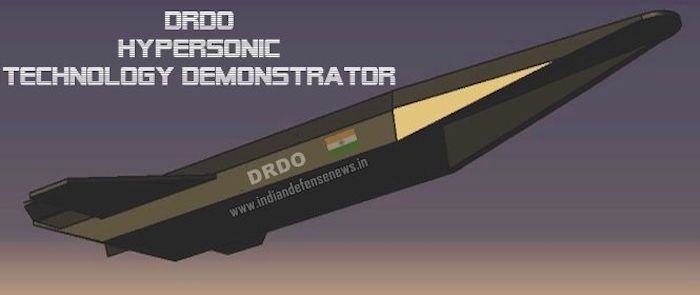
Bidding for their rightful place among the world’s majors, two of the country’s premier agencies are in the advanced stages of proving SCRAMJET (Supersonic Combustion Ramjet) technology to meet India's strategic needs. The Indian double has caught global attention in the hypersonic race for cheap and cost effective launch technology.
While the Indian Space Research Organisation (ISRO) is working on the Reusable Launch Vehicle - Test Demonstrator (RLV-TD) for launching satellites, the Defence Research and Development Organisation (DRDO) is dreaming about a Hypersonic Technology Demonstrator Vehicle (HSTDV) to carry a range of weapons faster and farther.
.
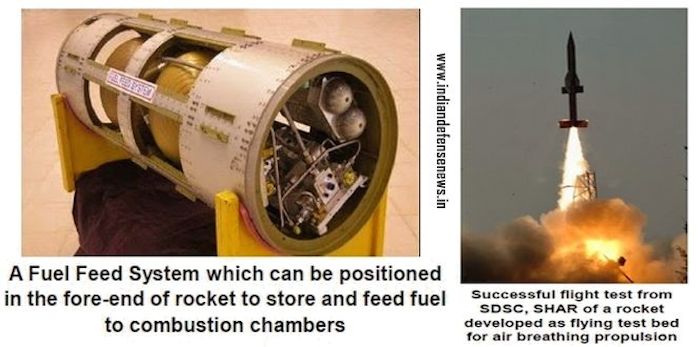
ISRO has already carried out a seven-second experimental combustion of a test engine. There’s a remarkable design difference between the RLV and the HSTDV. ISRO’s hypersonic plane, being built at the Vikram Sarabhai Space Centre (VSSC), Thiruvananthapuram, is a winged body while the HSTDV is a sleeker structure. The only common architecture, perhaps, is the air intake scoop at the front through which atmospheric air will be sucked in before oxygen is separated from it to oxidize the onboard fuel.
This is how the SCRAMJET bypasses the need to carry an oxidiser on board. In a conventional rocket, the fuel and oxidiser are stored separately and burnt in a regulated combustion of eight grams of oxygen to one gram of fuel. But in the SCRAMJET, oxygen is isolated from the air, compressed and introduced to a stream of fuel.
.
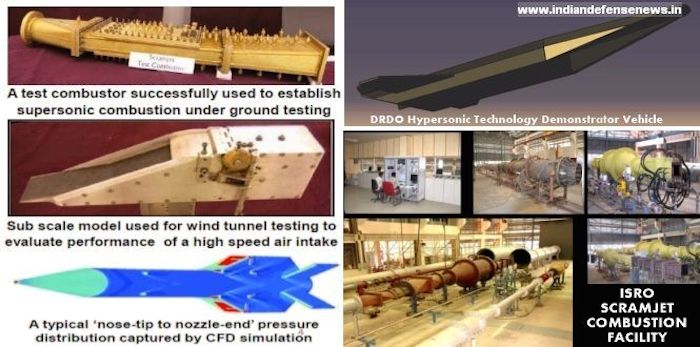
To ensure that sufficient oxygen is ingested for a self-sustaining flight, the SCRAMJET must get to supersonic speeds before going ahead with its designated mission of launching a satellite for ISRO or delivering a warhead for DRDO.
This speed is achieved by coupling the SCRAMJET to a conventional rocket during the initial phase of the flight. "We will mount the RLV prototype on a sounding rocket (S9). The rocket will speed it up to Mach 5 before the body is allowed to surf and suck air for onboard combustion. This process fires the SCRAMJET and propels the payload to the desired orbit at speeds between Mach 8 and 10.
The DRDO plans to use a core-alone Agni stage (S1). The capsule containing the HSTDV will ride on Agni to stratospheric heights. After the first stage separates, the capsule shifts to a horizontal alignment and opens up to allow the HSTD to skim the atmosphere and breathe air.
.
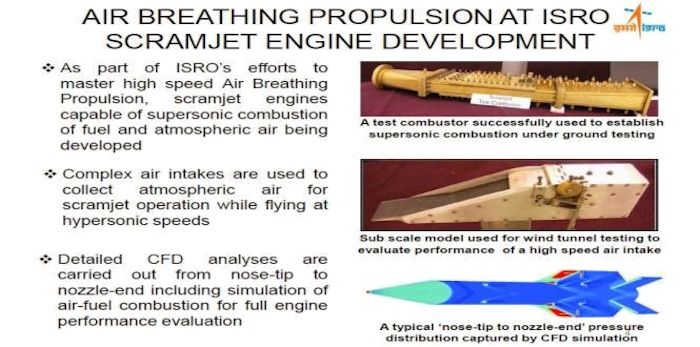
But like space rockets, ICBMs are a very costly chemical proposition. The hyperplane can fly in at fast speeds, fire the missile or launch the warhead and return. The reusability will reduce our costs significantly. Cost figures in ISRO’s calculus as well. The cost of launching a satellite using conventional rockets like the PSLV or GSLV is $25,000 to $28,000 per kg. The SCRAMJET can reduce it to $500. This will make any nation with such a technology a launch destination.
One great attraction is that the RLV can be brought back and reused. The conventional rocket is expendable. Each stage burns out as the payload soars. But the RLV will come back after its mission. ISRO will land the RLV on the sea using parachutes. But a project to facilitate its landing like an unmanned aircraft is on the anvil. DRDO also plans to land it like an aircraft. This technology is being experimented with. It can be integrated with the HSTDV.
Another frontier that SCRAMJET research has opened up is advanced metallurgy as the craft moves at great speeds, breaks off from the atmosphere and re-enters, weathering high temperatures and atmospheric friction. There are several new alloys being developed. Apart from their use in SCRAMJET vehicles, this research will impact the whole gamut of strategic metallurgy.
.
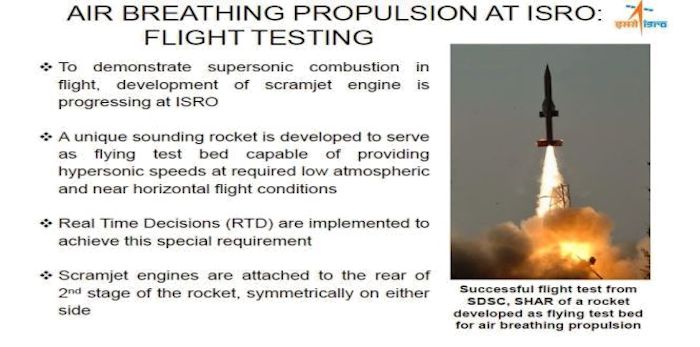
India is experimenting with silica-carbon-silica and nickel-based alloys to cover the SCRAMJET. Both alloys have high thermal resistance. A prototype using these alloys has been subjected to wind tunnel tests to gauge their strength against the vagaries of the atmosphere and beyond.
United States and China have been successful with SCRAMJET engines but the irony is they are yet to design materials which can withstand the heat generated from an object travelling at such high speeds. In a high speed aircraft, air friction cause extreme heating of the leading edge and temperature could be very high (Mach 5 generates 1,000 degree Celsius). Sadly, there is no technology available curently which can withstand such extreme heat. ISRO & DRDO are struggling very hard to crack this metallurgy.
The Indian Institute of Science (IISc) will play a key role in simulating the speeds and conducting tests in its newly commissioned hypersonic wind tunnel. This facility can test any object that will fly in space. The funding for the project is from the Defence Research and Development Laboratory, Hyderabad.
The 0.5 metre tunnel, which was commissioned in April 2014 is the second largest facility in the country; the largest is at the Vikram Sarabhai Space Centre of ISRO in Trivendrum.
It is but natural for anyone to wonder why two Indian agencies are developing the same technology in parallel, with so much, except the sophisticated nature of the end-use, in common. ISRO insiders blame it on the absence of a pro-active culture within DRDO’s portals; the latter finds fault with ISRO’s big brother attitude.
“It’s the typical Indian defence story,” says one former top gun of ISRO. “In a way, it’s a blessing in disguise. Whoever proves it first will attract global attention. With the country inching closer to the concept of aerospace strategic forces, there will be a lot of give and take once the technology is proved indigenously,” he adds.
HSTDV would give us a lead in hypersonic vehicle design, SCRAMJET, material technology and how to manage environment which is peculiar to hypersonic flying engines. HSTDV will be the equivalent of NASA's X43 and a huge achievement for our scientists once it's ready for use by the armed forces. And the SCRAMJET will place India in a league of nations that includes the US, Japan, China, Russia, Australia and Europe where this nascent technology is the latest scientific fad. (Adapted from ISRO, Indian Express, DRDO Newsletters & other Internet Sources)
Quelle: INDIANDEFENSE NEWS
4029 Views
